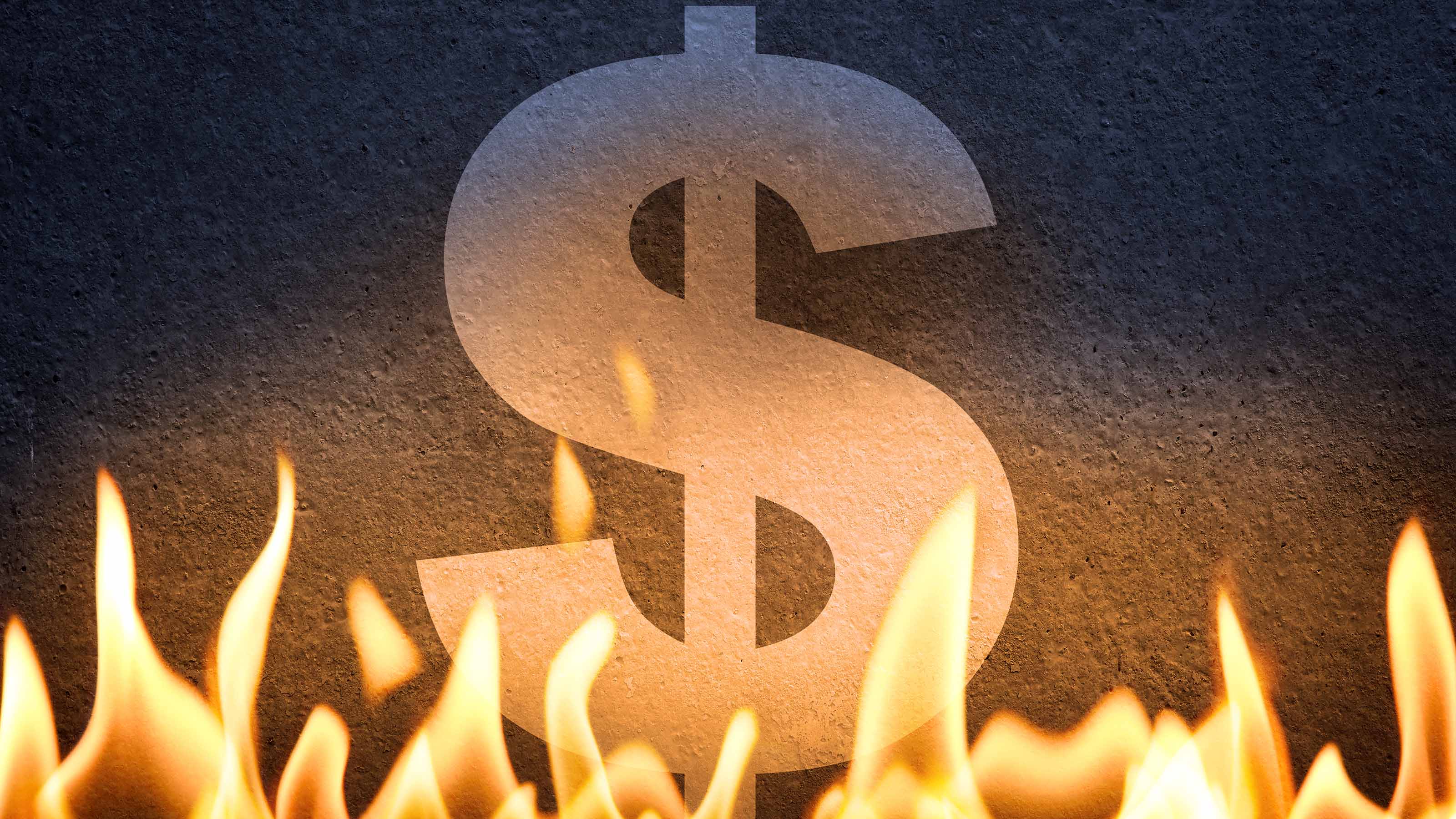August CPI Report: What the Experts Are Saying About Inflation
Headline inflation jumped last month but the Fed remains on course to leave interest rates unchanged.


Higher gas prices caused headline inflation to pick up sharply last month, the August Consumer Price Index (CPI) showed Wednesday, but a moderating pace of underlying inflation should keep the Federal Reserve on track to leave interest rates unchanged at the next Fed Meeting, experts say.
Prices rose 0.6% in August after increasing just 0.2% the prior month, the Bureau of Labor Statistics said Wednesday. The index for gasoline was the largest contributor to the monthly all items increase, accounting for over half of the increase, the BLS noted. Also contributing to the uptick in inflation was the shelter component, the index of which rose for a 40th consecutive month.
Although the 0.6% rise in monthly headline inflation matched economists' expectations, August's annual inflation rate of 3.7% exceeded expectations for a 3.6% gain.
From just $107.88 $24.99 for Kiplinger Personal Finance
Become a smarter, better informed investor. Subscribe from just $107.88 $24.99, plus get up to 4 Special Issues

Sign up for Kiplinger’s Free Newsletters
Profit and prosper with the best of expert advice on investing, taxes, retirement, personal finance and more - straight to your e-mail.
Profit and prosper with the best of expert advice - straight to your e-mail.
Core inflation, which strips out volatile food and energy prices and is considered to be a better predictor of future prices, continued to moderate, although pockets of "stickiness" remain. Core CPI rose 0.3% in August, or higher than economists' forecast for 0.2% growth. On an annual basis, core CPI increased 4.3%, which matched estimates.
The August CPI report adds to the evidence that the Fed's efforts to combat inflation by cooling a squeaky-tight labor market via an aggressive campaign of interest rate hikes is having an effect. It also tends to increase the odds of a Fed rate hike later in the year, experts say.
Interest rate traders assign a 97% probability to the Federal Open Market Committee (FOMC) leaving interest rates unchanged when it meets next week. The August CPI report didn't change those odds, but it did increase speculation in a November rate hike from the FOMC.
To recap: the FOMC raised the short-term federal funds rate by a quarter of a percentage point to a target range of 5.25% to 5.50% when it last met in July. The hike followed a pause in interest rate hikes at the Fed's prior meeting.
With the August CPI report now a matter of record, we turned to economists, strategists and other experts for their thoughts on what the data means for markets, macroeconomics and monetary policy going forward. Please see a selection of their commentary, sometimes edited for brevity or clarity, below.
Expert takes on the CPI report

"The still relatively moderate core inflation reading for August – the third month in a row – combined with the cooling labor market seen in the August payrolls report likely seals the deal for a rate-hike pause at the September FOMC meeting. That said, with the uncomfortable rise in headline inflation and continued rise in oil prices to near $90 per barrel, the Fed will likely want to still keep another rate hike on the table if the inflation moderation we have seen this summer doesn't continue." – Scott Anderson, chief U.S. economist at BMO Capital Markets
"The Consumer Price Index (CPI) was in line with expectations at the headline level but higher than expectations when excluding food and energy prices. It was clear that the increase in petroleum prices during the month was the culprit for much of the increase, as gasoline prices surged by more than 10% while transportation services prices increased by 2.0%. However, this also shows that consumers are still consuming and helping push prices higher. The slowdown in shelter prices, from an increase of 0.4% in July to 0.3% in August, is good news for the Federal Reserve (Fed), but the higher increase in services prices will keep the Fed in a defensive stance. The decline in core CPI (excluding food and energy prices) on a year-over-year basis is also a good omen for the Fed. However, the decision for next week's FOMC meeting will not be one to take lightly, especially because core CPI was higher than expected and because oil prices have continued to increase in September." – Eugenio Alemán, chief economist at Raymond James
"Inflation continues to be sticky. The surge in headline CPI, which includes food and energy prices, from 0.2% to 0.6% month-over-month and 3.7% from 3.2% year-over-year, is concerning. Observers tend to discount headline CPI as the food and energy components are seen as more volatile and not indicative of structural inflation or core CPI. However, these are real costs to the consumer and will pressure the central bank to hold rates steady or even consider additional interest rate hikes to achieve their desired 2% inflation target. Proving this point, odds makers now show nearly a 47% chance of a Fed rate hike in November. That's up from 41% before the news." – David Merrell, managing member, founder at TBH Advisors
"Inflation heated up again last month in the world's largest economy, driven mainly by rising oil costs. The core measure, which strips away volatile food and energy prices, cooled on an annual basis. This latest U.S. CPI data is unlikely to move the needle on the Fed's highly anticipated move to hold rates steady at their meeting next week – which has already been priced-in by financial markets. But the uptick in inflation gives the U.S. central bank extra reason to be hawkish moving forward. As such, we also expect the Fed will start to prepare the market for a rate increase at its November meeting." – Nigel Green, CEO and founder of deVere Group
"There still remains ground to cover in returning inflation to 2.0% on a sustained basis. Moreover, progress in reducing inflation over the next 12 months is likely to be more difficult than the past 12 months. The sizable drag on inflation from lower commodity prices has faded, while the pace of goods deflation is likely to slow with some initial froth worked off of vehicle prices. The road back to the Fed's inflation target is expected to remain bumpy as a result. The recent slowdown in inflation should be enough to keep the FOMC from hiking further this cycle, but with the path back to 2% likely to hold some further twists and turns, we expect rate cuts to be still be a ways out." – Sarah House, senior economist at Wells Fargo Economics
"While year-over-year CPI came in above expectation, increases for the month of August were mild with just energy coming in hot. We expect the Fed to act in line with market expectations and hold rates steady next week. If price pressures continue to hit consumers more than expected next month, we could see another rate hike before year end." – Ben Vaske, investment strategist at Orion Portfolio Solutions
"Today's inflation report provided confirmation that the Federal Reserve's monetary policy is continuing to reduce inflation over time. Core inflation rose 4.3% year-over-year for August, 0.4% lower than July's year-over-year increase. However, we did see increases in headline inflation month-to-month at 0.6% in August vs 0.2% for July, specifically related to increases in energy and gasoline prices. An additional bright spot in the report was the slowing of the shelter subcomponent of inflation, (7.3% year-over-year in August vs 7.7% for the prior month) – the shelter subcomponent represents a large portion of overall CPI. That said, in our view, the economy maintains decent momentum but is showing signs of slowing, and thus the Federal Reserve is likely to pause next week and wait for additional data to unfold for the November meeting." – Brian Pietrangelo, managing director of investment strategy at Key Private Bank
"Today's inflation report looked worse than it was. Headline and core were a little hotter than forecast, but shelter rose at the slowest pace in two years. Most of the contribution from the high reading came from energy and a surprise pop in airline fares. Used car prices also came down, which is encouraging for core. These numbers confirm the trend of lower shelter costs that market bulls want to see. But they're not decisively low enough to trigger a rally. Keep the champagne on ice and wait for next week. The Fed meeting is more important than ever. Policymakers will have to decide what to do with these numbers." – David Russell, vice president of market intelligence at TradeStation
""Headline CPI readings for August came in as expected at 0.6%, while core CPI surprised a tenth higher at 0.3%. Higher headline CPI was anticipated due to rising energy prices, and accelerated to 3.7% year-over-year. Even though core CPI surprised higher, at 4.3% year-over-year, it continued its downward trend due to the roll off of base effects. The Fed will be more focused on core CPI, which continued to show improvement as the three- and six-month annualized readings continue to trend below the year-over-year rate. However, services inflation ticked higher for the first time in several months, led by an increase in transportation and medical care prices. This report solidifies the case for the Fed to hold rates steady at next week's meeting and allow the lagged effects of monetary policy to filter through the economy, but keeps the possibility of another hike before year end on the table if services inflation remains sticky." – Jeff Hibbeler, director of portfolio management and senior portfolio manager at Exencial Wealth Advisors
"The Federal Reserve's mission is not accomplished. Stay away from bonds as the Fed will not be lowering interest rates until at least the second quarter of 2024. A strong economy bodes well for stocks." – Ken Moraif, founder and senior advisor at Retirement Planners of America
"Headline inflation rose by 0.4 percent month-over-month due to a spike in energy prices, suggesting there is still progress to be seen in restraining inflation. The Fed will likely seek additional data to confirm a temporary or an extended spike in headline and, potentially, core inflation as higher energy prices permeate throughout the broader economy, thus the expectation of a pause in tightening when the committee meets next week remains in place. Nevertheless, this was a report that nudges the FOMC towards a more hawkish position. NAFCU believes that even if future inflation data continues to exceed expectations, it is more likely to compel the FOMC to leave rates at their present level for longer, rather than forcing more rate hikes." – Noah Yosif, economist at the National Association of Federally-Insured Credit Unions
"Today's inflation report was good in that, for the most part, it met expectations. As such we would not expect any alteration to the outlook for a pause in raising rates at next week's FOMC meeting. But a broader view of above trend economic growth, tight labor markets, and inflation rates still well above the stated 2% target, should reinforce a Fed view that their job is not done. Longer term rates moving higher will keep the Fed on edge as they think about the stability of inflation expectations and could ultimately lead the Fed to consider a higher terminal rate than currently forecast." – Steve Wyett, chief investment strategist at BOK Financial
"Markets will likely look past the rise in headline inflation since the largest contributor will not likely be a main factor next month. Core inflation rose 4.3% from a year ago and will continue to decelerate as rent prices are expected to slow in the coming months. Yields on the 2-year Treasury are trading below yesterday's close, indicating that markets are taking the latest inflation report in stride as the Fed is expected to keep rates unchanged at its upcoming meeting." – Jeffrey Roach, chief economist at LPL Financial
"CPI came in this morning a touch higher than economists were expecting but we would say in line with what we were expecting given that rapid rise in energy and commodities over the past three months. The futures action this morning is muted as it appears in the near term that this number is not going to have a material impact however we believe that should the CPI number continue to remain sticky in September and October that one more rate hike from our friends at the Fed is likely on the table. As to what that means for the markets in general, we believe volatility will be with us through year end as the risk on assets that dragged the market higher through 2023 will begin to look expensive in the face of elevated yields." – Alex McGrath, chief investment officer at NorthEnd Private Wealth
"Today's inflation report was mixed. We're still seeing goods disinflation, particularly with used vehicle prices declining, but core inflation remains hot because of services, notably airlines. Those hoping to see disinflation within housing will be disappointed by this report. We think this has to be concerning for the Federal Reserve as well. One additional point of concern for the Fed is that core services, less energy services, remained at 0.4% for the second month in a row. That's a 4.5% rate annualized. We don't think this data print changes the expectation of the Fed pausing in September. Further, the data will not help the Fed make its case either for or against another hike this year. Looking ahead to next week's Fed meeting, it will be interesting to see the dot plot. If the dots indicate that there is one more hike by year-end, they will only have two more chances to raise rates – November and December. The market is indicating a 50-50 chance of another hike, and we agree. Market pricing as of this morning suggests today's inflation print is a non-event." – Mike Sanders, head of fixed income and portfolio manager at Madison Investments
Related Content
Profit and prosper with the best of Kiplinger's advice on investing, taxes, retirement, personal finance and much more. Delivered daily. Enter your email in the box and click Sign Me Up.

Dan Burrows is Kiplinger's senior investing writer, having joined the publication full time in 2016.
A long-time financial journalist, Dan is a veteran of MarketWatch, CBS MoneyWatch, SmartMoney, InvestorPlace, DailyFinance and other tier 1 national publications. He has written for The Wall Street Journal, Bloomberg and Consumer Reports and his stories have appeared in the New York Daily News, the San Jose Mercury News and Investor's Business Daily, among many other outlets. As a senior writer at AOL's DailyFinance, Dan reported market news from the floor of the New York Stock Exchange.
Once upon a time – before his days as a financial reporter and assistant financial editor at legendary fashion trade paper Women's Wear Daily – Dan worked for Spy magazine, scribbled away at Time Inc. and contributed to Maxim magazine back when lad mags were a thing. He's also written for Esquire magazine's Dubious Achievements Awards.
In his current role at Kiplinger, Dan writes about markets and macroeconomics.
Dan holds a bachelor's degree from Oberlin College and a master's degree from Columbia University.
Disclosure: Dan does not trade individual stocks or securities. He is eternally long the U.S equity market, primarily through tax-advantaged accounts.
-
 I'm want to give my 3 grandkids $5K each for Christmas.
I'm want to give my 3 grandkids $5K each for Christmas.You're comfortably retired and want to give your grandkids a big Christmas check, but their parents are worried they might spend it all. We ask the pros for help.
-
 If You're Not Doing Roth Conversions, You Need to Read This
If You're Not Doing Roth Conversions, You Need to Read ThisRoth conversions and other Roth strategies can be complex, but don't dismiss these tax planning tools outright. They could really work for you and your heirs.
-
 Could Traditional Retirement Expectations Be Killing Us?
Could Traditional Retirement Expectations Be Killing Us?A retirement psychologist makes the case: A fulfilling retirement begins with a blueprint for living, rather than simply the accumulation of a large nest egg.